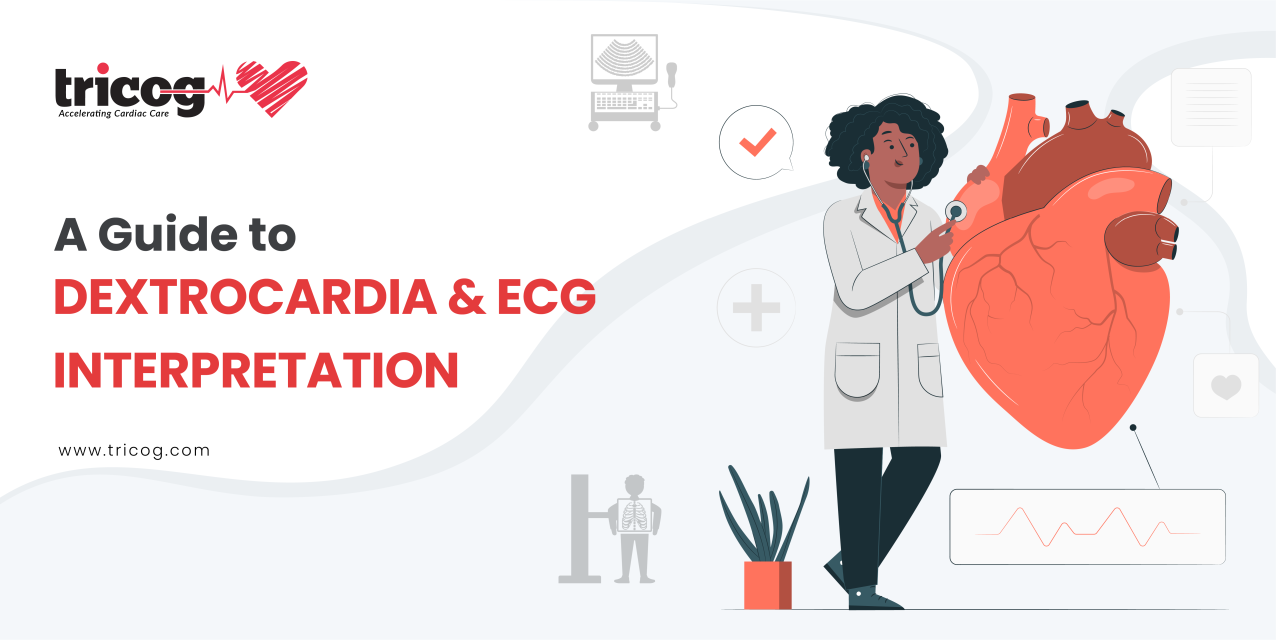
A complete guide about Dextrocardia & its ECG interpretation
A complete guide about Dextrocardia & its ECG interpretation
Dextrocardia is a rare congenital heart condition that is characterized by the presence of the heart on the right side instead of the normal left side. It is estimated that less than 1% of people may be born with Dextrocardia.
Quick facts about Dextrocardia
- The cause of Dextrocardia is not known.
- Only the right side location of the heart without any other defect is termed Isolated Dextrocardia
- Dextrocardia can be accompanied by anatomical defects of other organs too.
- Dextrocardia may be present in a condition called Situs Inversus. It is characterized by the opposite side location of many or all visceral organs like the liver, spleen, etc.
- Heterotaxy is a very serious syndrome that may appear with Dextrocardia. It is characterized by wrong positioning or improper functioning of various organs. For example, in some cases of Heterotaxy, the spleen may be completely absent or there can be several small spleens. In these conditions, the baby becomes prone to various infections.
- Kartagener syndrome is a condition that may occur in some people with mirror-image Dextrocardia. It is characterized by problems with the cilia that filter the air going into the nose and air passages.
Heart defects associated with Dextrocardia
- Double outlet right ventricle (connection of aorta to the right ventricle instead of the left ventricle)
- Endocardial cushion defect (poorly formed or completely absent walls that separate the heart’s four chambers)
- Pulmonary stenosis (pulmonary valve narrowing) or atresia (improper formation of pulmonary valve)
- Single ventricle instead of two ventricles
- Transposition of the great vessels (switching of the aorta and pulmonary artery)
- Ventricular septal defect (hole in the wall that separates right and left ventricles)
Symptoms of Dextrocardia
There may not be any symptoms associated with Dextrocardia and it could be accidentally diagnosed during a chest X-ray or MRI chest.
Isolated Dextrocardia increases the risk of lung infections, sinus infections, or pneumonia due to improper functioning of cilia.
Dextrocardia that affects the functioning of the heart can cause the following symptoms:
- Breathing difficulties
- Bluish discoloration of lips and skin
- Extreme fatigue even on minor physical activity
- Improper growth and development
- Jaundice
- Increased risk of infections
Diagnosis of Dextrocardia
Apart from scanning the chest, ECG can also diagnose Dextrocardia. But it requires an expert and experienced eye like the Team of Tricog Health who have successfully detected Dextrocardia only by interpreting the ECG readings.
ECG Features of Dextrocardia
- Right axis deviation
- Positive QRS complexes (with upright P and T waves) in aVR
- Lead I: inversion of all complexes, i.e. ‘global negativity’ (inverted P wave, negative QRS, inverted T wave)
- Absent R-wave progression in the chest leads (dominant S waves throughout)
- Low voltage in leads V3-V6
Treatment of Dextrocardia
Dextrocardia is a complete mirror image of a normal heart with no other symptoms that need no treatment at all. But the person needs to be educated to share this information with every physician and technician he visits for any medical assistance.
Other than this, treatment depends upon the problem of the person. Surgery may be required if there is any heart defect or any problem in the organs of the abdomen.
Prognosis of Dextrocardia
Dextrocardia without any organ abnormality has a normal life expectancy but Dextrocardia with organ abnormality needs treatment and its prognosis depends upon the severity of the other problems. In these cases, long-term use of drugs to manage the condition may help the patient.
Complications of Dextrocardia
- Blocked intestines (due to intestinal malrotation)
- Heart failure
- Recurrent Infection (due to Heterotaxy with no spleen)
- Infertility in males (due to Kartagener syndrome)
- Repeated cases of pneumonia
- Repeated sinus infections (Kartagener syndrome)
- Death
